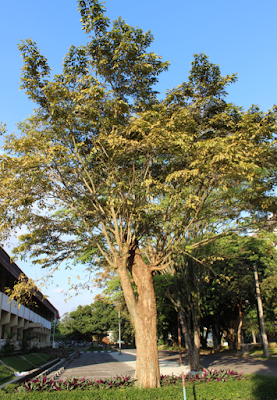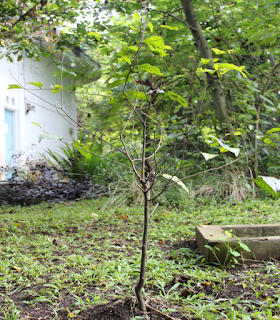Pterocarpus indicus Willd.
Pterocarpus indicus Tree
(Hidayat & Abdurrahman, 2017)
Pterocarpus indicus Tree
(Hidayat & Abdurrahman, 2017)
Leaves of Pterocarpus indicus
(Hidayat & Abdurrahman, 2017)
Pterocarpus indicus Tree (Fall)
(Hidayat & Abdurrahman, 2017)
Fruit of Pterocarpus indicus
(Hidayat & Abdurrahman, 2017)
Regnum : Plantae – Plants
Subregnum : Tracheobionta – Vascular plants
Divisio : Magnoliophyta – Flowering plants
Classis : Magnoliopsida – Dicotyledons
Subclassis : Rosidae
Ordo : Fabales
Familia : Fabaceae – Pea family
Genus :
Species : Pterocarpus indicus Willd.
Description
Description
Pterocarpus indicus is a big tree, growing to 33 m in height and 2 m
diameter. The trunks are usually fluted and buttressed to 7-m diameter at
the base. The crowns are large and bear many long branches that are at
first ascending, but eventually arch over and sometimes droop at the
ends. Trees with long willowy, drooping branches are particularly
conspicuous and attractive in Singapore and some parts of Malaysia and
Hawaii. Elsewhere the drooping habit may not develop. In a non-seasonal
humid tropical climate such as in Kuala Lumpur and Singapore, the trees
are generally evergreen, but in regions with seasonal rainfall, the trees are
deciduous (Orwa et al.2009).
The leaves are compound-pinnate, bearing about 12 alternate leaflets.
The leaflets are rather large, 7 x 3.5 to 11 x 55 cm and ovate to elliptic in
shape, with a pronounced acuminate tip.
The flowers are yellow, fragrant, and borne in large axillary panicles.
When flowering, the buds do not open in daily sequence. Instead, as buds
come to full size, they are kept waiting, to be triggered into opening. The
opened flowers last for one day. After that, several days may pass before
another batch of accumulated 'ready' buds open. The nature of the trigger
is unknown. Whole avenues of such trees blooming in unpredictable
synchrony making a splendid display (Orwa et al.2009).
The fruits, which take four months to mature, are disc-shaped, flat, and
have winged margins. About 5 cm across, the fruit have a central woodycorky bulge containing several seeds (ptero-carpus means winged fruit).
Unlike most legumes, the Pterocarpus fruit is indehiscent and is dispersed
by wind. It also floats in water and can be water-dispersed (Orwa et al.2009).
There are 1-3 seeds in each fruit.
Two distinct forms of P. indicus are recognized: P. indicus Willd. forma
echinatus (Persoon) Rojo and P. indicus Willd. forma indicus. The seed
portion of the pod of forma echinatus (common name pricky pear narra) is
covered with distinct bristle-like spicules, while the seed of forma indicus
are smooth (common name smooth narra) (Orwa et al.2009). The distribution of pricky narra
appears to be more limited than that of smooth narra. The end uses are
identical.
Pterocarpus is based on the Greek words ‘pteran’ meaning a wing and,
‘karpos’ meaning’ fruit.
This plant is common to use as shade or shelter tree, ornamental and have ecological impact as a nitrogen fixing agent. The leaves can be processed to make shampoo.
Location : UPI Gymnasium
Please cite this article as:
Azis, A. M. (2019). UPI Seed Plants: Pterocarpus indicus Willd. Online at
https://upiseedplants-one-aldi.blogspot.com/. Accessed (Date)
Please cite this article as:
Azis, A. M. (2019). UPI Seed Plants: Pterocarpus indicus Willd. Online at
https://upiseedplants-one-aldi.blogspot.com/. Accessed (Date)








Comments
Post a Comment